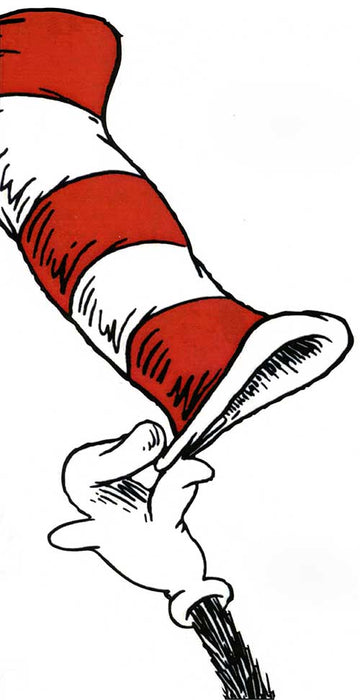
Look At Me! Look At Me Now!
Click to view image and pricing
Call 650-322-2200 for pricing
Dimensions: Single image size: 14” x 11”, diptych image size 17.5” x 26.5”
Medium: Giclee' on paper
Edition Size: 2500 single, 850 diptych
Availability: Available
Year of Release: 2023
There is a purity to our excitement when we accomplish something we never thought possible.
Such moments can peel away the years and instantly connect us back to our childhood, a time when egos were eclipsed by the sheer joy of having pushed ourselves forward. One can almost hear the echoes of our past voices shouting, “Look at me! Look at me now!”
So too was it for Ted Geisel, aka Dr. Seuss, upon writing The Cat in The Hat. The year was 1955 and Ted was challenged by his publisher to write a book using only 225 primer words. The hope was to empower early readers to go it alone, to do the unthinkable and read an entire book without assistance. The limited vocabulary proved a nearly impossible challenge for Ted, stating “I read the list forty times and got more and more discouraged. It was like trying to make a strudel without any strudels.”
“Ted struggled for over a year to make The Cat in The Hat, until finally deciding to identify the first two words on his list of primers that rhymed and use those as the basis of his story. When he matched “cat” with “hat” the light bulb went on and Ted’s momentum finally kicked in.
The Cat in the Hat was released in 1957 with the original jacket claiming “Many children will discover for the first time that they don’t need to be read to any more.” They were going to do the unthinkable, and in so doing, Ted would do the same.
The Cat in The Hat would go on to become one of the most important books in American literature and establish Ted as a “central character in the American literary mythology, sharing the pantheon with the likes of Mark Twain and F. Scott Fitzgerald,” (US News and World Report, 2007).
”Look At Me! Look At Me Now!” is a powerful metaphor for the moment in Ted’s life when he transcended children’s literature to become an American icon, and for all of us who have ever accomplished something we never thought possible.
FROM CONCEPT DRAWING TO FINAL ILLUSTRATION
When one looks closely at these two images we find subtle changes between the rough concept drawing and final illustration, with the sum of these changes adding to the precarious tension of the scene. If Ted truly wanted to convey what it feels like to accomplish the impossible, the precarious nature of the Cat balancing on the ball needed to push the limits.
